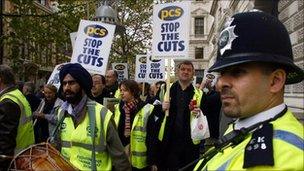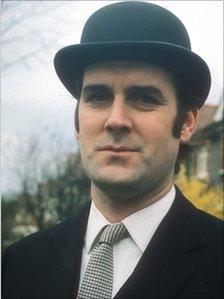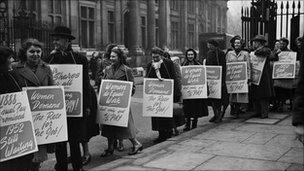Civil service pension scheme
- Published

The scheme is the fourth largest in the UK's public sector
Which employees does the scheme cover?
It covers the staff of 276 employers made up of government departments and non-departmental public bodies, such as museums, commissions and other organisations.
How many sections are there?
The Principal Civil Service Pension Scheme has four sections: Classic, Classic Plus, Premium and Nuvos.
Since 2002 new entrants have also had the alternative option of joining Partnership, a money purchase pension arrangement with employer contributions.
How many active, deferred and retired members do they have?
At 31 March 2010, there were 574,000 active members; 592,000 pensioners; and 345,000 deferred members.
About 58% of active members are in the Classic section, 3% in Classic Plus, 25% in Premium and 14% in Nuvos.
What are the principal benefits?
Nuvos has been the scheme offered to new joiners since 30 July 2007. It is a "career average" scheme with a normal retirement age of 65.
The Classic, Classic Plus and Premium sections are final-salary schemes with normal pension ages set at 60.

The civil service was the first big public service to offer all new recruits a career average scheme
Classic has a 1/80th accrual rate offering a half final-salary pension plus lump sum of 3/80ths.
It closed to new joiners in October 2002 when Premium was opened.
Premium has a 1/60th accrual rate offering a two-thirds final-salary pension, but with higher employee contributions.
Classic Plus was a one-off offer to Classic members, in which they could opt to park past service in Classic and build up further pension in Premium.
What percentage of salary do employees and employers pay?
Employer contribution rates from 1 April 2010 range from 16.7% of pay for those earning under £21,000 a year, to 24.3% for those earning more than £74,000 a year.
The average is 21.3% across all sections.
Employees in Classic pay 1.5%, others pay 3.5%.
What are the funding costs of the scheme?
A combination of the employer and employee contribution rates.
Is the scheme funded or unfunded?
Unfunded. It is paid for out of general taxation, not an underlying investment fund.
What is the value of the scheme's assets (if any) and its liabilities?
As at 31 March 2010 the scheme liabilities were estimated to be £153bn.
What is the average pension in payment?

Civil servants demand equal pay for women in 1952
The average pension paid to former civil servants and their dependants is £6,200.
Have there been any changes or reforms to the scheme in recent years?
Civil Service pensions were last changed in 2007. This followed earlier reforms in 2002.
Are there any further changes in the pipeline?
John Hutton is chairing the independent public service pensions commission which is due to make an interim report and will deliver its final report before the Budget 2011.
The government intends to revalue pensions in payment in line with inflation as measured by the consumer prices index (CPI) rather than the retail prices index (RPI).
Source: Cabinet Office.